You can read about the life and work of Leonardo da Vinci (April 15, 1452 - May 2, 1519), artist, inventor, engineer and undisputed epitome of "Renaissance man," almost anywhere (see the external links at the end of this article, for just a few resources).
Our interest here lies in two things, besides Leonardo's masterful gifts: His sexuality, and his enigmatic weaving of heretical, subtly sexual (dare we even say "gay"?) themes throughout his art.
Born in Vinci, Italy ("da Vinci" is not his surname; he is simply "Leonardo of Vinci," and referred to properly as just Leonardo), he was the bastard son of a landowner and a peasant girl (possibly a slave).
Leonardo was about 14 when he began his apprenticeship to painter Andrea del Verrocchio in Florence. In 1476, when he was 24 and still under Verrocchio's tutelage, he and three other men were arrested on sodomy charges after being accused, anonymously, of having sex with
17-year-old male art model and prostitute, Jacopo Saltarelli.
It is worth noting that making such a charge anonymously was not an uncommon way to retaliate against one's enemies at that time -- so there may not have been any substance to the charge at all. It is, however, worth wondering who may have had such a grievous vendetta against the young artist. While homosexuality was common throughout the Florence arts community, a formal charge of sodomy was no light matter. The Pope at the time was none other than the thoroughly depraved Sixtus IV (who, just two years later, would bestow his blessing on the Spanish Inquisition); a sodomy conviction could result in a sentence as mild as the humiliation of a public confession, or as serious as imprisonment, exile, or even death.
Too, a sodomy conviction would destroy the career of any artist whose livelihood depended on the patronage of the Church.
Fortunately for Leonardo, and for the rest of humankind, the charge was dropped, because there were no witnesses to the act. Still, the incident appears to have impacted Leonardo greatly; his private life became downright
secretive (and there is little doubt his cryptic "mirror writing," which he had been practicing since he was a child, came in handy for keeping his thoughts to himself).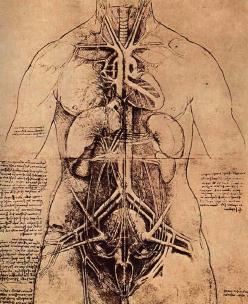
One of Leonardo's anatomical drawings of the human female. Note the reproductive system; does the area from the upper uterus down to the vaginal opening look like an animal skull with spiked horns to you, too? |
Nevertheless, enough is known about Leonardo to conclude that, if he was not a full six on the Kinsey scale, he was thoroughly uninterested in women
(despite La Gioconda, or the Mona Lisa, which some say may be an ironic self-portrait). Not only are Leonardo's sketches of the female nude almost gruesomely distorted, but even his depictions of heterosexual couplings, if not physically impossible, would be difficult to maintain for more than a moment by all but the most flexible Cirque de Soleil contortionists.
Leonardo's drawings of female nudes were likely the result of his study of cadavers; it is doubtful he ever had any intimate contact with a living woman. (He certainly never married, or fathered any children).
By comparison, Leonardo's notebooks are overflowing with studies of the male nude. One of his most frequent models was Gian Giacomo de Caprotti, a youth who came to live with the artist around the age of ten, and whom Leonardo nicknamed "Salai" -- "lamb of Satan" or "child of Satan," for the boy's frequently insufferable behavior. While no artist in his right mind would put up with such an incorrigible model (or even an apprentice) for long, Salai -- also a frequent subject of note in Leonardo's writings -- stayed with him for nearly twenty years.
Leonardo spent the last decade of his life with one Francesco Melzi, a young nobleman and artist in his own right, often referred to as the Leonardo's "most beloved pupil," who became the executor of Leonardo's estate, and inherited the whole of the master's works.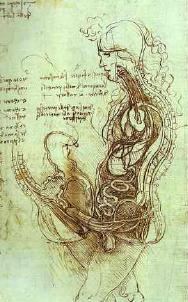
One of Leonardo's nearly-impossible heterosexual coitus positions, Coition of Hemisected Man and Woman, c. 1492 |
Naturally, the Catholic Encyclopedia refers to Melzi as nothing more than Leonardo's "friend."
Speaking of Leonardo's death, it is often noted that Leonardo kept just two of his own paintings within sight as he lay dying: La Gioconda (the Mona Lisa) and one of John the Baptist (which he painted of his own accord, and not by commission of the Church or any other patron). Bear this seemingly insignificant but of trivia in mind, as we will soon learn there is nothing trivial about it at all.
It is also not lost on many observers that the peace-loving (and vegetarian) Leonardo was strangely fascinated by weapons of war; he invented the machine gun, after all.
Speaking of phallic symbols, it was in 1910 that Leonardo was officially outed by Sigmund Freud, who concluded after intense study of Leonardo's art and notebooks, that Leonardo was a big homo. While Freud's conclusion is supported by the evidence, Freud naturally proffers his usual specious theories for Leonardo's sexuality -- in short, thatLeonardo's homosexuality originated from an unusually close relation with his mother, and ... Leonardo was without his father for the first few years of his life. Furthermore for Freud, homosexuality was linked to love of self and therefore narcissism, from which he suspected Leonardo suffered greatly. For example the narcissistic urge to do just enough to impress may have led to his trail of unfinished but admired work. Narcissism, or love of self, would also mean that Leonardo worked to express his self-love, rather than love of art or science. This lead [sic] naturally to a further analysis by Freud of the Mona Lisa smile, suggesting that the same smile can be found in his other works, and was in essence an embodiment of himself.
Freud extended these ideas and applied the techniques of dream analysis to both the 'Mona Lisa' and the 'Saint Anne with Madonna and Child', and concluded that behind the simultaneous unbounded tenderness and sinister menace of the smiling faces, lay the memory of the fateful caresses of Leonardo's mother, 'who like all unsatisfied mothers... took her little son in place of her husband.'
Like the bulk of his hypotheses, Freud's attempt at dream interpretation is faulty at best. Even the most untrained eye can appreciate the relational dynamics between figures in the master's greatest works; the careful and deliberate positioning of figures (i.e., "body language") is in no way an accident of Leonardo's dream state.
We will examine The Last Supper and a few other, less-recognized examples of what Leonardo may have been trying to tell us. First, let us return for a moment to Leonardo's sodomy arrest in 1476. We have discussed the potential consequences had Leonardo been convicted. In truth, however, it is unlikely he would have been put to death; more "sodomites" were exiled or sentenced to prison or to some form of public humiliation at that time in Italy. (Burning at the stake was more common in France and Spain, where the Inquisition was already well under way; it just hadn't received the official blessing of the Church yet.)
The Church's primary target was not mere "sodomites," but unrepetant heretics -- especially witches. There is much discussion in The Malleus Maleficarum on the subject of incubi and succubi (bad angels, or devils, who physically engage in sexual intercourse with human beings). Considering the language used in 1486, the Malleus is fairly clear about the "sin" of homosexual activity (caused, of course, by these bad angels):Also it must be carefully noted that, though the Scripture speaks of Incubi and Succubi lusting after women, yet nowhere do we read that Incubi and Succubi fell into vices against nature. We do not speak only of sodomy, but of any other sin whereby the act is wrongfully performed outside the rightful channel. ...
But the very devil of Fornication, and the chief of that abomination, is called Asmodeus, which means the Creature of Judgement: for because of this kind of sin a terrible judgement was executed upon Sodom and the four other cities. Had Leonardo's anonymous accuser wanted to inflict more pain on Leonardo than that of an unwarranted arrest, he or she would have conspired to link the alleged sodomy incident with demon possession, thus "proving" heresy -- and virtually guaranteeing a death sentence. But since no one came forward to support the sodomy charge, Leonardo was a free man.
Ironically, the Church was, and would remain, oblivious to the fact that it allowed one of the most unrepetant heretics of all to go free.
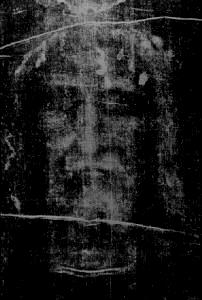 Let us turn our attention to a piece of work not normally associated with Leonardo: the Shroud of Turin -- the 13-1/2-foot-long piece of fabric bearing a photographic-like imprint of the crucified body of a very tall man, believed to be the burial shroud of Jesus (because, states the Catholic Encyclopedia, "various pronouncements of the Holy See cannot be disputed"). Let us turn our attention to a piece of work not normally associated with Leonardo: the Shroud of Turin -- the 13-1/2-foot-long piece of fabric bearing a photographic-like imprint of the crucified body of a very tall man, believed to be the burial shroud of Jesus (because, states the Catholic Encyclopedia, "various pronouncements of the Holy See cannot be disputed").
In the long history of attempts to verify the Shroud's authenticity, researchers Lynn Picknett and Clive Prince stumbled across evidence that convinced them the Shroud is not only a fake, but a very clever work by -- you guessed it -- Leonardo, using a camera obscura (a pinhole-lightbox projecting an image an artist can trace).
An excellent overview of what Picknett and Prince discovered can be found in issue 110 (May, 1998) of The Fortean Times, and covered in complete detail in the researchers' book, Turin Shroud: In Whose Image?.
But why would Leonardo do such a thing? There has been speculation that he did it at the request of Sixtus IV as a "relic" to galvanize the faithful, or simply out of his own devotion to Christ.
While the former may be true, the latter -- according to the researchers -- is highly unlikely. Picknett and Prince correctly note that no devout Catholic would have dared fake the image of Jesus' body and blood. Beyond that, however, Leonardo may well have taken gleefully to the task, as yet another project in his lifelong crusade against the Church.
Against the Church? Isn't this the man who painted some of the most ethereal and indelible images of the Madonna and Christ? Isn't this the artist whose work the Church calls "immortal masterpieces," without which "Raphael's 'Madonna', his 'Belle Jardinière' and 'Madonna of the Goldfinch' would not exist"?
Furthermore, note the researchers, the appearance of the Christ-figure's head as seemingly decapitated may not have been a mistake by the master, but a deliberate and clear message to those who shared Leonardo's devotion to not Jesus, but John the Baptist -- who was, of course, beheaded.
"We believe,"
they write in issue 111 (June, 1998) of The Fortean Times, "that Leonardo ... managed to incorporate his 'Johannite' imagery into the Turin Shroud... [W]e believe that the Maestro wanted us to see the head as severed; the subliminal message is 'he
who was beheaded ia above -- morally and spiritually -- one who was crucified."
Picknett and Prince delve far deeper into the strong case that Leonardo was "an adherent to a religion that was opposed to Jesus, the signs of which can be found coded within the symbolism of his works." Much of this conjecture has to do with the Prieuré de Sion, or Priory of Sion.
In his runaway bestseller of 2003, The Da Vinci Code (2003), author Dan Brown blended fact with fiction so well that an entire mini-industry of books claiming to crack the "code" has sprung up around his novel.
Brown claims (in the section "Facts") that the Priory of Sion is "a European secret society founded in 1099" (other sources say 1090) for the purpose of restoring the Merovingian dynasty of Frankish kings who ruled parts of modern-day Germany and France from the 5th to 8th centuries, C.E.
Brown got his information from Holy Blood, Holy Grail (1982) by Michael Baigent, Henry Lincoln, and Richard Leigh, who claim that their investigation into the secret power structure of France ultimately led to the discovery that the Merovingian dynasty is actually the direct bloodline of Jesus and Mary Magdalene, kept suppressed for centuries so as not to rock the Catholic Church's carefully-crafted version of a superhuman, sexless Jesus.
The truth about the Priory of Sion may be much more mundane:The Priory of Sion is an esoteric order legally established in France in 1956 by Pierre Plantard (1920-2000), yet claiming great antiquity. Legends connected with the Priory of Sion have generated great interest through the years, particularly as a result of the publication in 1982 of The Holy Blood and the Holy Grail by British journalists Michael Baigent, Richard Leigh, and Henry Lincoln. The story starts with Father Berenger Saunière (1852-1917), whose last name is also borrowed in The Da Vinci Code, who in 1885 became the parish priest of Rennes-le-Château, a small village in the French region of Aude, near the Pyrenees Mountains. Saunière, it seems, was a rather strange character, deeply interested in symbolism; he also had a penchant for building a number of constructions around his parish church, including a bizarre neo-gothic "Tower of Magdala".
"Yet another theory," offers The Priory of Sion Hoax, "proposes that the Priory of Sion was an invention of the Surrealists. In his book Cosmic Trigger III, Robert Anton Wilson gives strong play to his wife Arlen’s theory that the Priory is really a pataphysical conspiracy initiated by 'grand master' Jean Cocteau. (Pataphysique, an art movement created by Alfred Jarry at the beginning of the 20th century, had strong links to Surrealism, Dadaism, and Concrete Poetry; in essence, it postulated that the main mission for art was to bullshit people.) In essence, a massive hoax pulled off as sort of a giant work of performance art."
Picknett and Prince write in FT111 that although they "have grave problems with much of the authors' hypothesis" in Holy Blood, Holy Grail, "the relevant point here is that the ninth Grand Master of the Priory of Sion was, allegedly, Leonardo da Vinci."
Truth or not, with this allegation in place, a closer look at Leonardo's religious works becomes more interesting than ever. And if it is true, it lends great weight to the subliminal anti-Christ, pro-John-the-Baptist messages running rife throughout Leonardo's works.
The Last Supper
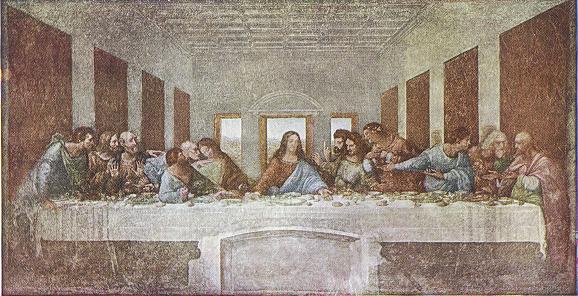
An exquisite masterpiece of composition (biographer Kenneth Clark rightly deemed it "the keystone of European art"), The Last Supper depicts the split-second after Jesus has announced to his Apostles: "One of you will betray me." (That is the most generally accepted interpretation, anyway; note Emil Kren and Daniel Marx: "others feel that it also represents the introduction of the celebration of the Eucharist by Jesus, who is pointing to the bread and wine with his hands. And yet others feel it depicts the moment when Judas, by reaching for the bread at the same moment as Jesus as related in the Gospel of St Luke (22:21), reveals himself to be the traitor.")
We are all familiar with the more obvious imagery (e.g., Judas Iscariot, the betrayer, leans back and away from Jesus, while clutching a small money sack), and countless in-depth analyses of the now-all-but-destroyed masterpiece exist, including much discussion of apparent anomalies (such as the apparently disembodied hand clutching a dagger), but our specific concern is with three of the Apostles.
The young St. John (not the Baptist, but the other St. John), the figure to Jesus' immediate right (leaning his head away, almost into the profile of grey-haired St. Peter), is depicted as practically androgynous.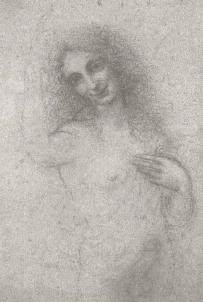
An example of Leonardo's gender-bending. This preliminary sketch, known as Angel of the Flesh, was made for a lost painting, The Annunciation. |
But is this figure -- with its round, hairless cheeks, small hands, and difficult-to-ignore cleavage -- really John?
More than a few observers are convinced this is actually Mary Magdalene (who, depending on who you ask, was indeed present at the Last Supper). A good, concise briefing on this topic can be found at The Last Supper: Mary Magdalene on Jesus' Right from LisaShea.com (which has numerous other informative and entertaining articles of related interest).
To Jesus' left (directly behind a shocked James the Greater) is Thomas, commonly referred to "The Doubting Thomas."
Write Picknett and Prince: "And why is [Thomas] thrusting an upright forefinger into [Jesus'] face in a clearly menacing fashion? This is what we came to dub as the 'John gesture' for, wherever it is found in Leonardo's works, it is a handy reference to John the Baptist."
Placing John the Baptist at the Last Supper would have meant committing a deliberate anachronism, as John was already dead, so perhaps Thomas (aptly, the doubter) is given the "John gesture" in order to serve as John's
proxy.
Considering that just a handful (about two dozen) completed paintings of Leonardo's remain in existence, the frequency of "Johannite" imagery is, if not ubiquitous, surprisingly frequent. Less frequent, but just as noticeable, is Leonardo's wont of painting himself into various religious scenes -- invariably facing away from Jesus. In The Last Supper, Leonardo appears as Thaddeus, second from the far right, with his back to Jesus. (Picknett and Prince agree that this figure is Leonardo, but disagree with most sources that the figure represents Thaddeus; the authors say that this could be either St. Thaddeus or St. Jude.)
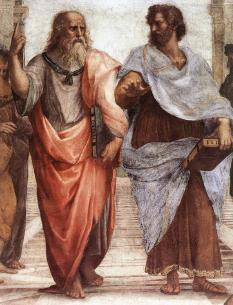 In light of all this speculation, it appears that Raphael made an in-joke in his own fresco, The School of Athens -- he used Leonardo as the model for the figure of Plato (with his pupil, Aristotle, at the dead-center of the painting), with Plato/Leonardo making the "John gesture." In light of all this speculation, it appears that Raphael made an in-joke in his own fresco, The School of Athens -- he used Leonardo as the model for the figure of Plato (with his pupil, Aristotle, at the dead-center of the painting), with Plato/Leonardo making the "John gesture."
The traditional interpretation of this pair says that Aristotle's hand, roughly parallel to the ground, symbolizes his connection to Earth, whereas Plato's finger, pointing towards Heaven, symbolizes the teacher's more metaphysical view of the universe.
However, knowing what you know now about Leonardo and the "John gesture," do you suppose Raphael's depiction of Leonardo as Plato is mere coincidence?
The Virgin of the Rocks
The heads of most Catholic apologists explode whenever the subliminal imagery of this painting is discussed.
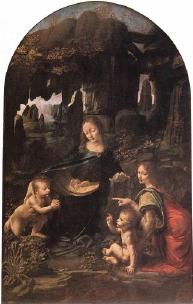 Of Leonardo's The Virgin of the Rocks, Picknett and Prince write that while the Virgin Mary is traditionally assumed to have her arm around St. John, who is kneeling to receive a blessing from Jesus, seated next to the angel Uriel, logic dictates that the figures of Jesus and John should be reversed: Of Leonardo's The Virgin of the Rocks, Picknett and Prince write that while the Virgin Mary is traditionally assumed to have her arm around St. John, who is kneeling to receive a blessing from Jesus, seated next to the angel Uriel, logic dictates that the figures of Jesus and John should be reversed:The Virgin's hand is outstretched some distance above Jesus' head, while Uriel's pointing finger dissects the space beneath. But surely Jesus should be with his mother and the Baptist with the angel Uriel, traditionally his guardian? The child with Uriel is sitting close to a pool or stream -- surely an allusion to baptism? Thus you come face to face with an alarming heresy; it is John who is blessing Jesus and Jesus who is kneeling in submission to John.
The Virgin's outstretched hand is a threatening claw. And it is not too fanciful to imagine her long fingers grasping the top of an invisible head, whose severed neck is indicated by Uriel's pointing finger. Once again, a subliminal reference to John the Baptist, who of course was beheaded. Picknett and Prince also point out the seemingly obvious phallic-and-testicular structure of "the rocks."
(Note that there are two versions of The Virgin of the Rocks. The one now hanging in the Louvre is shown here; the one in the National Gallery in London, in which Uriel's raised hand is missing, may be the work of Leonardo, partly his work, or may be a copy by another artist altogether. See Leonardo's Geology: The Authenticity of the Virgin of the Rocks by Ann C. Pizzorusso.)
Now you know why Catholic apologists go nuts when art historians discuss The Virgin of the Rocks.
After all this, is there any wonder now why Leonardo kept his darkest depiction of the "John gesture" near his deathbed?
Look at the side-by-side comparison of the "dark" John with the Mona Lisa below. While most question whether the Mona Lisa was really a self-portrait, there is no question that the two paintings could be portraits of brother and sister -- or are they the same person? At the very least, they share that same enigmatic smile.
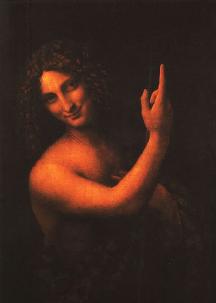 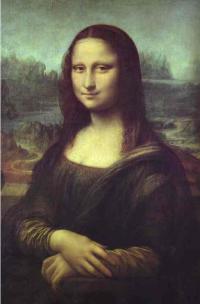
"If, as seems to be the case," writes Lynn Picknett in Mary Magdalene: Christianity's Hidden Goddess, "Leonardo was both the Mona Lisa and the face on the Shroud, then he achieved a unique double coup; he not only became the universally recognised image of the Son of God, but also the 'Most Beautiful Woman in the World' - no wonder 'she' is smirking
mysteriously!"
Whatever Leonardo's reason for keeping these two paintings within sight as he lay dying, the master has taken the truth to the grave -- but left us with a wildly intriguing series of clues, reflected in those all-knowing smiles.
Leonardo's Other Secrets
Vegetarianism. Leonardo's sexuality and heresy were not the only secrets in his closet. Although he didn't really hide it, he was a vegetarian -- a daring thing in an era during which the Church emphasized the concept of man's dominion over all other living things -- to the point that vegetarianism was, for centuries, a capital crime in the eyes of the Church, punishable by death.
In his book, Food for the Spirit, Steven Rosen writes:The early Christian fathers adhered to a meatless regime... many early Christian groups supported the meatless way of life. In fact, the writings of the early Church indicate that meat eating was not officially allowed until the 4th century, when the Emperor Constantine decided that his version of Christianity would be the version for everyone. A meat eating interpretation of the Bible became the official creed of the Roman Empire, and vegetarian Christians had to practice in secret or risk being put to death for heresy. It is said that Constantine used to pour molten lead down the their throats if they were captured. Notes the paper Beasts of Burden from Antagonism Press: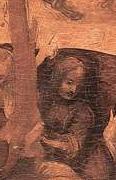
Detail of another "John gesture," this time from Adoration of the Magi. Picknett and Prince tell us "this is not any tree, it is a carob which, in standard iconography, is a symbol for John the Baptist." |
Cathar heretics brought before the Emperor Henry III in 1052 were accused of having 'condemned all eating of animals, and with the agreement of everybody present he ordered them to be hanged'. ...
It was amongst such heretic tendencies that radical communistic ideas often flourished, circulating amongst the poor and providing inspiration for 'millenarian' revolts. In this context the refusal of meat may have had a class dimension: 'another thing about not eating meat which gave it a social power as a spiritual message, and it was a message which was preached not only by the Cathars but by other religions which opposed Catholic orthodoxy in this period, was that meat was the food of the hunters, of the dominators, of the people who rode horses, the people who exploited the cultivators of the land, most of whose life was singularly meatless'. Even today, the controversy over whether or not vegetarianism is truly "Christian" is surprising to those of us unconcerned with either practice, or both.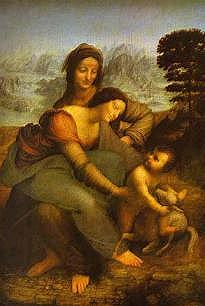
Virgin and Child with St. Anne: Is the Baby Jesus symbolically "decapitating" John, the "true lamb"? And did Leonardo model St. Anne after himself? |
Lefthandedness. Leonardo was also left-handed. Lefthandedness -- as with all natural traits outside the "norm" -- was considered a sign of Satan; the word for "left" (as in "left turn," or "left hand") in Italian is sinestra, which comes directly from the Latin sinister. The French word for "left" is gauche, which means (and which has been adopted by English speakers to mean) unfashionable, lacking class, or awkward.
In addition, writes Adrian E. Flatt, M.D., FRCS, in The Sinister Handed:"Old English used the words lift or left with a primary meaning of weak or worthless; in Middle English left survived as an indication of side. Gradually the terms left, left hand, and left-handed developed derogatory meanings, and even in Roget's Thesaurus the word unskilled has left-handed, equivocal, and sinister as synonyms.
"The word left still has negative connotations. Recently a group of college freshmen and sophomores were asked their subjective feelings about the words left and right. Left was represented by bad, dark, profane, female, night, west, unclean, curved, limp, homosexual, weak, mysterious, low, ugly, incorrect, death. Right was thought to be good, right, saved, male, clean, day, east, straight, erect, strong, heterosexual, commonplace, high, beautiful, correct, life." Even modern Australian slang offers the word mollydooker for a left-handed person ("dooker" for duke, or fist, and "molly" to indicate effeminacy, weakness, sissiness, homosexuality).
Muses Steve Carroll in This is York (August 8, 2002): "Southpaw, clumsy and, most bizarrely, "son of the devil". I have been called them all. Why? Because I am left-handed. I suppose I should be grateful - 400 years ago I would probably have been burned at the stake."
Desecration of dead bodies. Leonardo learned anatomy from the dissection of cadavers -- itself an immense heresy. Somehow, Leonardo won permission from the Church to continue his study of dead bodies.
But then, Leonardo got away with a lot, didn't he?
Further
reading:
Leonardo
Da Vinci by Kenneth Clark
The
Da Vinci Code by Dan Brown
Leonardo
da Vinci and a Memory of His Childhood (1910) by
Sigmund Freud
Cosmic
Trigger III by Robert Anton Wilson
The
Heretic's Feast by Colin Spencer
Mary Magdalene: Christianity's Hidden Goddess by Lynn Picknett - in which the author discusses the possibility that the Mona Lisa is really a self-portrait of Leonardo in drag, as well as the suggestion that Leonardo used himself as the model for St. Anne in The Virgin and Child with St Anne (c. 1510)
The Templar Revelation by Lynn Picknett and Clive Prince
External links:
St. John the Baptist in the Wildnerness / St. John the Baptist as The Bacchus - image of one of Leonardo's particularly sexually-ambiguous males; this time, Bacchus displaying the "John gesture"
Christianity & Vegetarianism - Robert Tappan, JesusVeg.com
Did Leonardo da Vinci Believe that Mary Magdalene was the Beloved Disciple?
Does 'The Da Vinci Code' Crack Leonardo? - Bruce Boucher, The New Age Center
Fact Paper 35 - Samuel Kurinsky and Father Franco Bontempi, Hebrew History Federation, Ltd. Summary: Report that Leonardo da Vinci's mother was Jewish. Leonardo expressed Amadean precepts through his art, representing St. John as Judaic law, presenting St. John (the Old Judaic Religion) as the path to divine knowledge.
Google Answers: Da Vinci's Last Supper - interesting discussion on the possibility that the figure of St. John is actually Mary Magdalene
The High-Ranking Heretic? Every Picture
Tells a Story - Fortean Times, June, 1998
The Holy Shroud (of Turin) - Catholic Encyclopedia
The Languages of Left: What the World thinks of Lefties - The Sinister Shop
The Last Supper: Leonardo da Vinci, Mary Magdalene, The Hand and KnifeLisaShea.com - highly recommended
Leonardo, The Last Supper: The figure of John and face detail - University of Chicago Press
Leonardo da Vinci - Catholic Encyclopedia
Leonardo da Vinci and the Voynich Manuscript - Edith Sherwood Ph.D
Leonardo Da Vinci: Gênio Gay? - an astrological explanation of Leonardo's sexuality; in Portuguese
Leonardo da Vinci: Sources and Expressions of His Genius - Joan Farber Johnson
Leonardo, Left-Handed Draftsman and Writer - Carmen C. Bambach, Metropolitan Museum of Art
Site officiel du musée du Louvre / Louvre Museum Official Website
The Merovingian Dynasty: Bloodline of Jesus or Synagogue of Satan? - Watch Unto Prayer
The Mona Lisa and The Last Supper - mystery.tv
Mysteries of the Shroud - Fortean Times, May, 1998
Olga's Gallery: Leonardo da Vinci
Prieure de Sion & The Treasures of Rennes-le-Château - Official International Website, Ordo Supremus Militaris Templi Hierosolymitani®; The Magistral Grand Priory of The Holy Lands (Notre Dame, Saint Mary of Magdalene)
priory-of-sion - Yahoo! Groups discussion list "of issues and theories arising from the book "Holy Blood, Holy Grail" and similar works dealing with such diverse topics as the Knights Templar, Rennes-le-Chateau, Rosslyn Chapel, the Holy Grail, Merovingian and alleged Rex Deus dynasties and related themes in areas such as Freemasonry, Rosicrucianism and the Qabbalah."
Priory of Sion - The Pierre Plantard Archives
1937-1993
Priory of Sion Deception Papers
The Priory of Sion Hoax: An A-Z
Priory of Sion: The Facts, The Theories, The Mystery
Author Robert Anton Wilson Speaks With The TVI Times, May 15, 2001 - in which Wilson touches on the tale that Jean Cocteau was the 23rd Grand Master of the Priory of Sion, and wonders aloud if all such orders, Freemasons included, "are all an elaborate joke."
The Roman Catholic Church on Animals - Excerpted from the Catechism of the Catholic Church, Beliefnet.com
Vegetarianism & Christianity - Connie Bendickson, Vegetarian Baby & Child Magazine, May/June, 2002
Vegetarianism in the Bible - Denis Giron, The Nazarene Way of Essenic Studies: "When I first began to study the bible, the people I studied with told me that it was wrong for me to be a vegetarian. I have found a common attack by Christians, and even Muslims on vegetarianism goes along the lines of 'God said we could eat meat. Are you trying to say you are more merciful than God?'"
Copyright © 2004 Joyce A. Rogers. All Rights Reserved.
Back to Good Reads
|
|